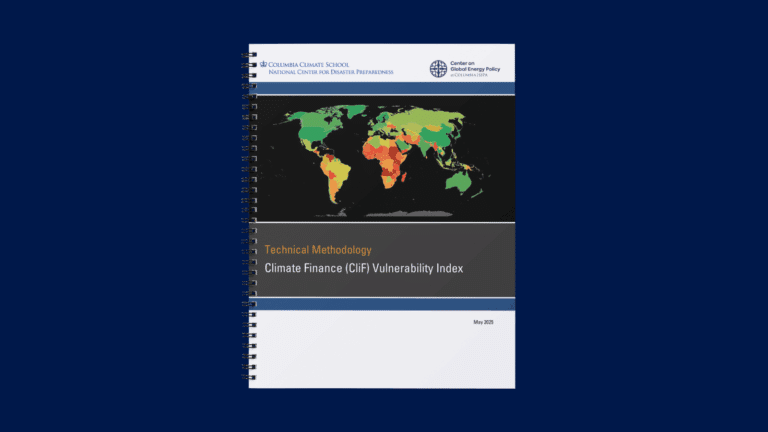On 28 November 2022, Zimbabwe stopped generating electricity at the South Power Station of the Kariba Dam (Kariba South) on the Zambezi River. The problems at Kariba lay bare the deepening humanitarian crisis in Southern Africa[1], which is struggling with the intensifying effects of global warming and indebtedness. In this Q&A, Harry Verhoeven, a senior research scholar at the Center on Global Energy Policy (CGEP), answers questions about the immediate crisis and the future of hydropower on the continent.
Why did Kariba South shut down?
Historically low rainfall has led to a glaring imbalance between the water intake level at Lake Kariba—the world’s biggest dam reservoir—and water consumption by the Zimbabwean Electricity Supply Authority at Kariba South.[2] As a result, the Zambezi River Authority (ZRA), which maintains and operates the Kariba Dam, has issued guidance to suspend electricity generation until early 2023 at Kariba South.[3] The ZRA, jointly owned by Zimbabwe and Zambia, believes this decision would allow most of the remaining water left in Lake Kariba (currently at a paltry 4.6 percent of capacity) to be used by Zambia. Zambia has rationed its water consumption more carefully than Zimbabwe, which has become more hydropower dependent as it battles outages and soaring fuel prices owing to the Russia-Ukraine conflict.[4]
The ZRA is a rare example of international co-management of transboundary waters and associated hydro-infrastructure.[5] While in many river basins, including in the Nile Basin,[6] information exchange and integrated action about developmental challenges or environmental threats remain elusive, the ZRA has mostly avoided damaging political wrangling by incorporating both technocrats and elected government leaders in its structures. But despite the ZRA’s reputation for competent stewardship, fears of an existential crisis at Kariba have been accumulating for years.[7]
Why is the Kariba Dam so important?
The significance of the Kariba Dam, with an installed capacity of 1626 megawatt, stems both from its contributions to regional economies and what it symbolizes in Southern Africa[8] and beyond. The dam was controversially built in the late-colonial period to accelerate economic growth in settler colonies under white-minority control, but ended up becoming central to newly-independent African states.[9] Today, Kariba provides the bulk of electricity consumed in both Zambia and Zimbabwe. While Zimbabwe has been one of Africa’s agricultural powerhouses, Zambia is a big global supplier of copper and cobalt that require energy-intensive production but are also crucial for energy transitions around the world.
The decision to suspend generation at Zimbabwe’s main electricity source came amidst power outages that have already crippled the country’s basic industrial and agricultural activities. Ironically, this could leave Zimbabwe almost wholly reliant on ageing coal-fired power plants while increasing the risk of illegal logging by the poor for heating and cooking.[10] Moreover, the drying up of the Kariba reservoir has devastating consequences not only for electricity generation and regional water security, but also because it undercuts traditional strategies in Zambia and Zimbabwe for adapting to climate variability. For example, flood recession farming through garden plots, along the banks of the Zambezi and other smaller streams, has historically been key to sustaining livelihoods of communities. But it is now increasingly difficult as flowing rivers become scarce.[11]
What are the deeper-lying causes of this crisis?
The devastating 2008 cholera outbreak in Zimbabwe raised questions about the ability and willingness of Robert Mugabe’s ZANU-PF government to safeguard basic infrastructure.[12] Speculation that the dam might collapse has been rife for years.[13] The bedrock on which the infrastructure stands has been gravely eroded by routine operations at Kariba, triggering a decade of emergency repair interventions. But today’s crisis goes far beyond what the ZRA could address through safety protocols and engineering.
In 2016, NASA documented the decline of Lake Kariba due to increasingly potent episodes of the El Niño–Southern Oscillation.[14] The IPCC has concluded that, as a result of climate change, Southern Africa is experiencing significantly higher-than-average increases in surface-level temperature and decreases in mean levels of precipitation, while simultaneously having to confront occasional extreme flooding.[15] The reservoir behind the Kariba Dam has not been at full capacity since 2011 and may only fill up again under rare circumstances.
Sovereign indebtedness is undermining these economies’ ability to pay for repairing Kariba and build climate change adaptation capacity. During the Covid-19 pandemic, Zambia defaulted[16] on its debt and interest repayments, which were scheduled to be four times higher than what the country could afford to spend on climate action in 2021.[17] Zimbabwe, which owes more than US$13.5 billion to global creditors, [18] too, has been shut out from external financing, including World Bank and IMF funding mechanisms.[19] It has had to confront protracted drought and deadly cyclones such as Idai in 2019 and Ana in 2022 virtually alone. International climate financing remains insignificant to help meet these challenges.[20]
What are the implications of Kariba South shutdown for hydropower in Africa?
While the shutdown at Kariba is the result of local factors, the crisis is bad news for infrastructure developers on the continent that expected steady expansion driven by thirst for low-carbon electricity. To be sure, over the last two decades, dam building did make a spectacular comeback in Africa as projects were initiated in Ghana, Liberia, Rwanda, Tanzania and elsewhere. This was fueled through a combination of financial assistance and technical expertise offered by China, India, Brazil and Gulf States[21] and the desire of some African states to emulate the success of their Asian partners in using infrastructure to shore up political and economic sovereignty.[22] Billions of dollars have been spent on new or upgraded dams and, partly owing to this competition from (re-)emerging powers, the World Bank has also reprioritized infrastructure in Africa.[23]
Yet the revival of dams in Africa is stalling. The continent’s most ambitious dam-building states, Ethiopia[24] and Sudan[25], have seen their construction programs go off track or be suspended because of domestic political struggles. Shifting considerations of Africa’s new dam financiers have also contributed to stagnation.[26] For example, Beijing is cutting back some of its loan facilities to African partners as it remains preoccupied with the financial crisis and Covid-19 pandemic at home.[27] Kariba infamously lacked any environmental impact assessment[28] and its troubles are highlighting critiques of big dams. These include displacement of communities—the predicament of tens of thousands of Tonga people in the case of Kariba[29]—and hydropower’s long history of broken promises pertaining to compensation and resettlement.[30]
The complex politics of displacement deters many possible funders of dam building as do the long time-horizons required for planning and investing, which most African states simply cannot sustain without extensive and predictable external support. One popular argument in favor of dams used to be their storage capacity to deal with precipitation variability.[31] But as reservoirs run dry at[32] Kariba and elsewhere, it’s clear that climate change is also increasing the risk of dams failing to make their promised contributions toward electricity generation and facilitating permanent irrigation.
[5] MJ Tumbale (Ed.), “Management of River Basins and Dams: The Zambezi River Basin.” AA Balkema, Rotterdam, 2000.
[12] Simukai Chigudu, “The Political Life of an Epidemic: Cholera, Crisis and Citizenship in Zimbabwe.” Cambridge: Cambridge University Press, 2020.
[29] Terence Mashingaidze, “Beyond the Kariba Dam Induced Displacements: The Zimbabwean Tonga’s Struggles for Restitution, 1990s–2000s.” International Journal on Minority and Group Rights, 20 (January 2013): 381. 10.1163/15718115-02003003
[32] Iman Mallakpour, Amir Agha Kouchak, Mojtaba Sadegh, “Climate‐induced changes in the risk of hydrological failure of major dams in California.” Geophysical Research Letters 46, (January 2019): 2130–2139. https://doi.org/10.1029/2018GL081888





